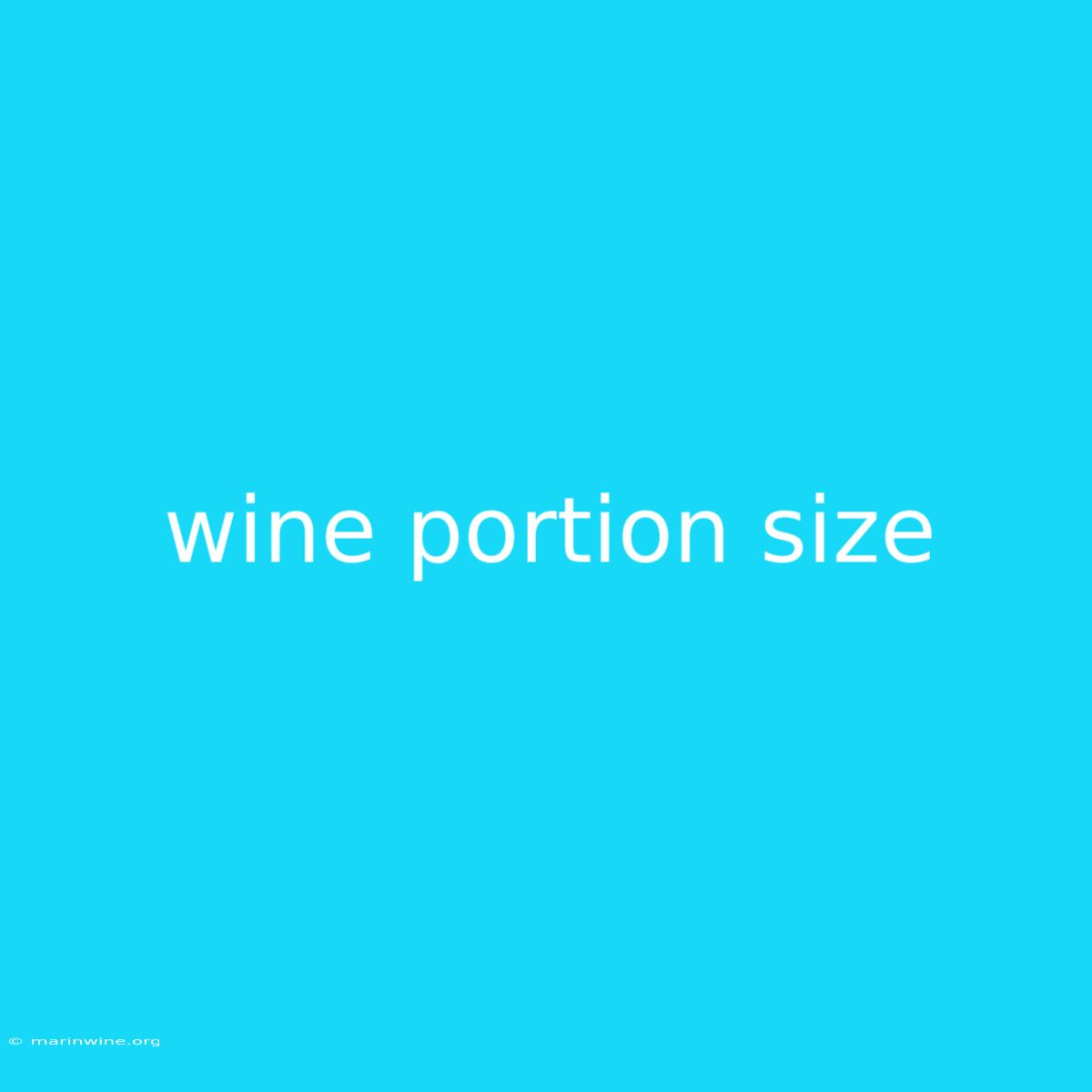What's the Perfect Wine Portion Size? Uncorking the Truth About Moderation
Editor’s Note: Wine, a beloved beverage enjoyed globally, often sparks debates about its ideal serving size.
Why It Matters: Understanding proper wine portion sizes is essential for enjoying its flavors responsibly while maintaining good health. This article delves into the recommended guidelines, health implications, and factors influencing wine portion sizes.
Key Takeaways of Wine Portion Size
| Key Takeaways | Details |
|---|---|
| Standard Wine Pour: 5 ounces (148ml) for red, white, and rosé wines | This is a commonly accepted standard used in restaurants and bars. |
| Moderation Matters: Limiting intake to one or two servings per day is crucial for maintaining a healthy lifestyle. | Excessive consumption can lead to health complications. |
| Individual Factors: Body weight, metabolism, and tolerance influence how alcohol affects individuals. | Consider these factors when determining your appropriate serving size. |
Wine Portion Size
The enjoyment of wine often hinges on the perception of the "perfect" pour. However, "perfect" is relative and influenced by factors like personal preferences, health considerations, and cultural norms.
Standard Wine Pour
A standard wine pour is typically considered 5 ounces (148 ml) for red, white, and rosé wines. This serving size has been adopted by many restaurants and bars for consistency. However, it's important to note that this standard is a general guideline and individual needs may vary.
The Influence of Wine Type
While the standard pour remains consistent, different types of wines can impact the overall alcohol content and, consequently, the perceived size. For instance, fortified wines like port and sherry are often served in smaller quantities due to their higher alcohol content.
Health Implications of Wine Consumption
Alcohol Content and Health
Wine, like all alcoholic beverages, contains alcohol, which can affect the body's functions. The alcohol content of wine can vary, with some wines containing a higher percentage than others. The potential health risks associated with alcohol consumption are directly related to the amount consumed.
Moderate Consumption and Potential Benefits
Scientific research has explored the potential health benefits of moderate wine consumption, particularly for red wine. These benefits are often attributed to the presence of antioxidants like resveratrol. It is crucial to emphasize that moderate consumption is key.
The Risks of Excessive Drinking
Excessive wine consumption, like excessive alcohol intake in general, can contribute to various health problems, including:
- Liver disease: Excessive alcohol intake can damage the liver, leading to conditions like fatty liver disease, alcoholic hepatitis, and cirrhosis.
- Cardiovascular disease: Excessive alcohol consumption can raise blood pressure, increase the risk of heart attack, and contribute to other cardiovascular issues.
- Cancer: Some studies suggest a link between excessive alcohol consumption and an increased risk of certain cancers.
- Neurological disorders: Excessive alcohol consumption can damage the brain, potentially leading to cognitive impairment, memory problems, and other neurological disorders.
Factors Influencing Alcohol Tolerance
Individual tolerance to alcohol can vary greatly, influenced by factors like body weight, metabolism, gender, and even genetics. Therefore, the "right" serving size is not one-size-fits-all.
How to Determine Your Ideal Portion Size
- Start small: Begin with a smaller pour than the standard 5 ounces and assess how your body reacts.
- Listen to your body: Pay attention to how you feel after consuming wine. If you experience any negative side effects like dizziness, lightheadedness, or impaired judgment, reduce your intake.
- Seek professional advice: If you have any concerns about alcohol consumption or your health, consult a doctor or a registered dietitian.
FAQ
Q: Is it better to drink wine with meals or on an empty stomach?
A: Consuming wine with meals can help slow down the absorption of alcohol into the bloodstream, potentially reducing its impact.
Q: Does the type of wine influence how it affects me?
**A: ** The type of wine can affect the alcohol content, and thus, its overall impact. For instance, fortified wines often have higher alcohol content.
Q: What are some tips for enjoying wine responsibly?
A: Drink slowly, alternate wine with water or non-alcoholic beverages, and avoid drinking on an empty stomach.
Q: Is it safe to drink wine while pregnant?
A: No, it is not recommended to drink alcohol during pregnancy. Alcohol can harm the developing fetus.
Q: How can I learn more about responsible wine consumption?
A: Consult your doctor or a registered dietitian. You can also access resources from organizations like the National Institute on Alcohol Abuse and Alcoholism (NIAAA).
Tips for Wine Enjoyment
- Explore new wines: Sample a variety of wines to discover new flavors and preferences.
- Pair wine with food: Experiment with different pairings to enhance the flavors of both wine and food.
- Learn about wine regions: Explore the different wine-producing regions and their unique characteristics.
- Join a wine club: Connect with other wine enthusiasts, learn about new wines, and participate in tastings.
Summary of Wine Portion Size
This article explored the importance of understanding wine portion sizes for both responsible enjoyment and health. It highlighted the standard wine pour, the influence of wine type on alcohol content, and the potential health implications of both moderate and excessive alcohol consumption. Remember, enjoying wine responsibly involves being aware of individual factors and making informed choices based on your body's needs and health goals.
Closing Message:
Wine, with its rich history and diverse flavors, offers a unique sensory experience. By being mindful of portion sizes and prioritizing responsible consumption, you can savor its pleasures while safeguarding your well-being.

